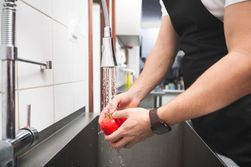
If you own a busy restaurant, your grease trap can help you to protect your plumbing and the pipes of the local water supply. However, like any other building component, grease traps require occasional maintenance, like grease trap cleaning. Here are a few do’s and don’ts regarding your grease trap.
Do:
Have your grease trap cleaned frequently.
Since fats, oils, and grease (FOG) float to the surface of your grease trap, having your system cleaned regularly is essential for preventing issues like sewage clogs. Schedule a cleaning at least once a month, as a grease trap that is 25% full of these floating substances can short-circuit your system.
Hire a professional.
While it can be tempting to clean your business’s grease trap yourself, the job can be incredibly messy and difficult to accomplish without the proper equipment and training. Grease trap cleaning professionals can accomplish the task quicker, and they’ll dispose of fats and oils according to state law—helping you avoid penalties and fines.
Don’t:
Use enzymes or solvents.
 Certain cleaning products can kill helpful bacteria that help to break down grime. Never use products like bleach or caustic solvents in drains that lead to your grease trap.
Certain cleaning products can kill helpful bacteria that help to break down grime. Never use products like bleach or caustic solvents in drains that lead to your grease trap.
Connect your trap to dishwashers.
Never allow your dishwasher to connect directly to your grease trap. In addition to filling it with additional wastewater, the high temperature can make the FOGs congeal, causing foul odors and potentially costly messes.
When it’s time for your next grease trap cleaning, turn to Great Bear Septic Service for help. With a commitment to helping businesses throughout Westchester, Putnam, and Southern Dutchess counties, NY, this trusted company has received numerous awards for their excellent service, including the best of their category by Home Advisor. Visit their website to learn more about their services, or call (845) 621-0250 to schedule a maintenance appointment.
About the Business
Have a question? Ask the experts!
Send your question

